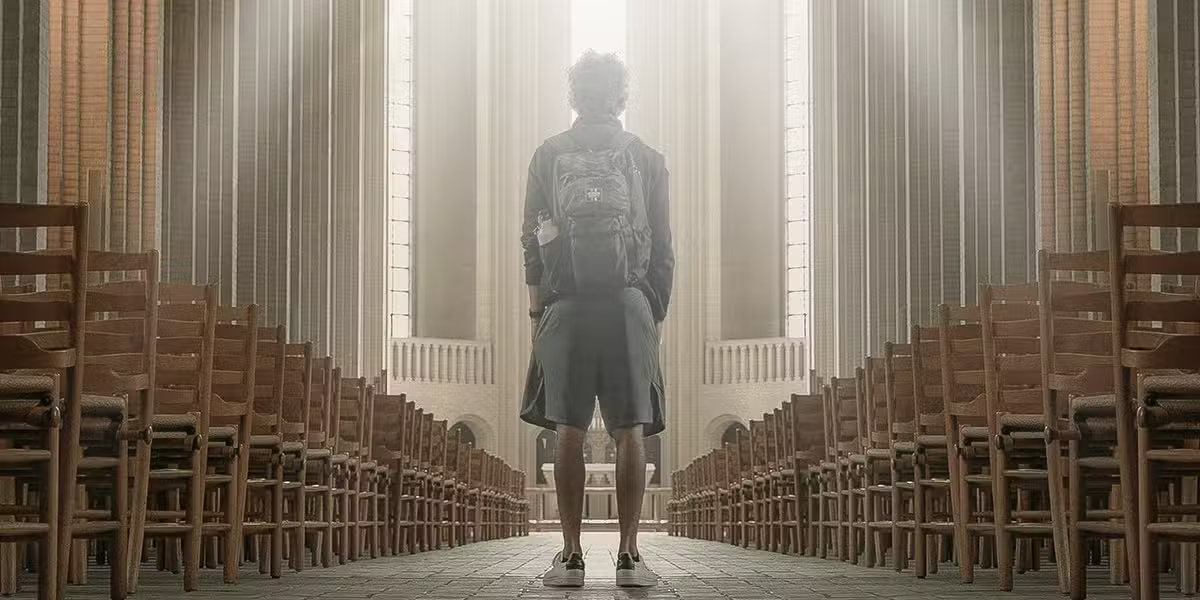Most movies pull the viewer in through chaos, madness, or emotion. Basic storytelling says that there needs to be an emotional hook—an inciting incident of some sort—to engage a viewer and pull them in. But dramatization or romanticization is not always an accurate depiction of life.
Though life is certainly filled with lots of inciting incidents and plenty of emotion, few movies have attempted to capture the in-between that makes up most of our lives: the monotonous routines, the nine to five, the minor hiccups, the passing conversations, the subpar dinners with your partner, the moments of deep abiding content with your partner, walking the dog, drinking a beer—the overall flow of each day.
The movie, Paterson, however, (released in 2016 but recently made available on streaming platforms) starring Adam Driver and directed by Jim Jarmusch, does just that. It is the most contemplative movie I’ve ever seen, inspiring you to see the grace in monotony, receive each moment as a gift, and experience the liberating depth in everything.
I highly recommend watching Paterson for yourself to get its full experience, but since it captures the fullness of everyday life, a number of its themes will still be reminders to each of us, whether you’ve watched the movie or not.
1) Each moment is a gift.
The movie depicts the daily life of a city bus driver named Paterson—how he writes a poem every morning on the bus before his shift starts, drives around the city and picks people up, humorously listens to the everyday conversations he hears from the driver’s seat, returns home to his partner, eats dinner with her, takes his dog on a walk, grabs a pint at the neighborhood bar, and then crawls back into bed with his lover. That is, basically, the entire movie. Seriously. In each scene, the main character displays a certain enjoyment, light-heartedness, and amusement toward reality, positioning him to receive each moment as the gift that it is. Each day is a little different—his interactions, the conversations he hears, the challenges he encounters, and his time with his lover—but the movie unfolds, day after day, just as our weeks do, and invites us to learn something from the main character’s disposition.
Whenever I have gone on retreats to monasteries, I often hear other retreaters say, “I love it here, but I could never live the way that the monks do!” Whether it’s the monks’ isolation, celibacy, or rigorous prayer schedule, something about the foreignness of their lifestyle leads to a mental disconnect. Paterson, however, reminds you that it is possible to be a monk in the modern world. The man’s contemplative posture—the joy he experiences in writing poetry each morning, his contentment in a job that is not flashy, his gentle grin and curiosity as he listens to the conversations of strangers on the bus, and his openness to relational intimacy with his partner—is accessible, making you believe that you, too, can be a monk in the modern world. He is committed and dedicated to the people in his life and his tasks, yet he does not take himself too seriously or idolize anything. Sure, he has his flaws, but so do monks!
His life is marked by a radical simplicity and awareness. It is profound, inspiring, and even convicting. When I pitched this blog to my editor, his response was, “I loved that movie. It haunted me for weeks.” He’s right—the movie, which reflects the attitude of the man, is so simple that it’s haunting. And yet, his posture toward reality feels doable, just by opening our eyes a little more to receive the gift in each moment, even if it is merely finding the humor in a conversation you overhear or noticing the beautiful quirks of your lover.
2) Authentic creativity is personal.
The lie that most in my generation tend to believe (myself included) is that one’s life must stand out in some way—that it must be noticeable and noteworthy. Social media, of course, only fuels this notion, creating in each person a psychological need for validation. This lie is only intensified in creative spaces, it seems, though we artists pride ourselves on being “authentic.” But being different isn’t necessarily authentic. And in sharing our deep, personal creations, it is sometimes easier to become even more desperate for attention or validation. This is natural, as there is a certain vulnerability to sharing your creations, but it’s also maddening.
In Paterson, both Paterson and his partner are artists who create just to create. Paterson is a poet who tries to write each morning before his bus shift, and his partner is a designer who basically turns their house into her canvas each day, painting patterns on the walls or on the curtains. Paterson is not on a reckless pursuit to publish his poetry (his lack of sharing his poetry with others, in fact, might be his greatest flaw), and his partner spends her days designing and painting with no thought of financial reward. They are in the world but not of the world. They are simply playing a different game. In fact, the worldly mind might find it maddening that he “works” (makes money) all day while she paints walls, and, at times, becomes stressed about her artistic pursuits! Yet, they make it work financially and are incredibly happy in the simple life they’ve created together. In a touching scene at the end, the cupcakes she cleverly designed is a big hit at the local farmer’s market, and she excitedly takes Paterson on a date with the money she made. It was a couple hundred dollars.
Their approach to creativity is the exact opposite of the energy prevalent in Los Angeles, New York City, or Nashville, where the temptation is for artists to create, not for themselves, but to make a name for themselves. Paterson opens his poetry book each morning because he enjoys writing poems, and his partner takes out her paintbrush each day because their house is her creative playground.
3) Fullness is simplicity.
I used to think that if I wanted to be an artist then my life had to be filled with drama, chaos, or a marginalized existence that lacked belonging. Perhaps you’ve witnessed people who self-sabotage or throw grenades into their reality, just to stir things up or make things vague and smoky in order to thrive off of the confusion. The characters in Paterson remind us that a beautiful, simple, creative life can flow out of belonging and contentment, not isolation and chaos. Living out a beautiful story in the day to day does not have to have an intense plot.
I’m a very emotional person who, in a sense, might always feel misunderstood and tortured in my soul because I do not feel like I belong in the world—yet Paterson reminds me that I can detach myself from the world, make my own rules in the world, and simultaneously rest in the spaces of belonging, security, and safety that are available through people, partners, and divine encounters in the world. Paterson inspires me to see the beauty and depth in the seemingly insignificant moments of the passing day, where there is a deep peace, contentment, and joy existing in the ordinary and mundane. Like visiting any monastery, in watching Paterson, what you find is that simplicity is the opposite of boring—it is profound. It rises out of a deep place of being united with Christ and loved by God. You realize that you already have everything that you need, that you belong to God and that God—all that is true, honorable, right, pure, lovely, and admirable—already belongs to you.








